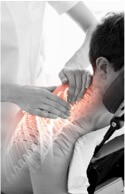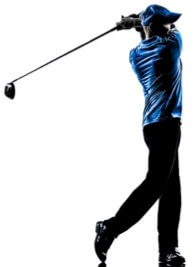I want to examine a fairly complex relationship between these four areas – neck, back, shoulders and ribs.

The connection between neck and back is obvious. It is basically a one to one relationship: the neck stacks directly over the upper back vertebrae, with some shifts in how the spine is shaped. But as soon as you hit the collarbone, ribs, and shoulders, everything gets complicated. You go from a simple column supporting the head to a very complex set of relationships.
Let’s look at the rib cage more closely.
Each rib connects into two different vertebrae, one above and one below. The ribs move with each breath and need to be flexible to allow for enough air in the lungs and also so the spine can move as intended. The ribs also act as a support for the shoulders. The shoulder joint is incredibly flexible because it is not encased in bone but rather lots of muscle that connects into the back, ribs and shoulder blade. If a rib is even a little rotated it will strain the spinal muscle that connects to it. It is very important to the body that the ribs stay in line as they protect some of our most vital organs. So often “back pain” is really a rib that isn’t moving correctly.

f the ribs are rotated (for example, from slouching) the shoulders that sit on top of them will follow – leaving you with a hump at the base of your neck and shoulders that roll forward. This puts a lot of strain on the neck, since the base of the neck connects into the shoulders and upper ribs. It can also lead to headaches and put pressure on the nerves that run to your arms and hands. In extreme cases, it can lead to carpal tunnel syndrome.
So basically, if the rib cage is not aligned correctly, the spine, neck, and shoulders will all be out of whack.
Not to mention it can restrict breathing by not giving the lungs and diaphragm enough room to move.
Here are a few things you can do to help correct all these things together, and you need to look at them all together because they really are directly connected.
- Sit up tall, at all times. Slouching is terrible for your body both inside and out. If you sit in an office a lot, try to plant both feet flat on the floor. This will remind your body of its base and help you to sit taller.
- Pay attention to where your shoulders are. Your shoulders should be in line with your midline. To check this, stand up straight and put your hands at your sides. If your shoulders are in line your hands should hang right at the middle of your legs.
- Twice a day, stop and take a few deep breaths. Try to breathe into the rib cage (not your belly) this activates the diaphragm more and gets the ribs to roll through their full movement. It will also help your spine.
- Get yourself unstuck with Rolfing. If you find any of these movements difficult, confusing or painful then come see us at Michigan Rolfing and we will get you functioning again and feeling great!

